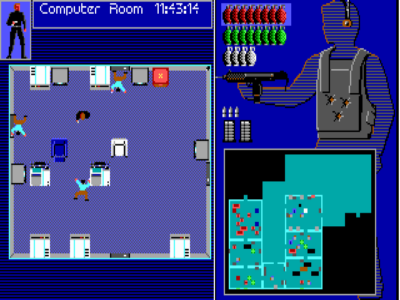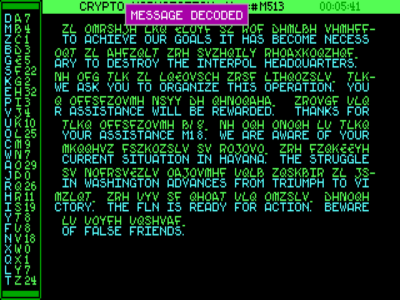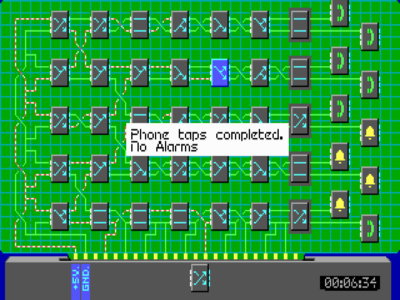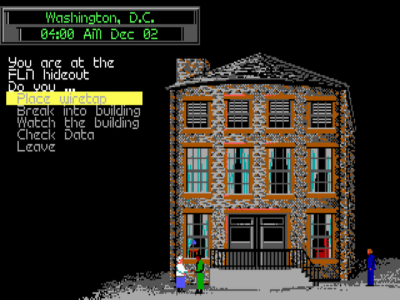
Covert Action
Written by: Rik
Date posted: January 27, 2007
- Genre: Action
- Developed by: Microprose
- Published by: Microprose
- Year released: 1990
- Our score: 6
For those of us with even a passing interest in old games, it is occasionally worth delving into the murky cauldron of reasons why we might choose to spend a portion of our free time hunched in front of our expensively-acquired and artificially slowed-down PCs, ignorant of our ever escalating relationship, alcohol and personal hygiene problems, somehow gleaning pleasure from a few badly-animated blobs lurching around on screen in time with a few pudgy-fingered jabs at the keyboard.
Nostalgia aside, a key factor is arguably the opportunity to play and experience games that, for one reason or another, you may have missed the first time around. As someone who relied on the family Atari ST for gaming fun during his childhood, a few exciting (and more processor hungry) games of the era were out of bounds, released into the gleeful arms of smug Amiga owners and kids whose dads let them play on their work PC.

The spy game is all about stealth, not about gunfights and piles of dead bodies – well, if you’re a good spy, that is.
Covert Action was one title to fall foul of the ST embargo, and I have to admit to mild pangs of excitement at finally getting it up and running on the PC. I’d actually forgotten it was a Sid Meier game; though clearly a genius and all-round gaming god, I haven’t had too much to do with his other work over the years, mainly because the scale of most of his games is so grand that just thinking about playing any of them would most likely make my head explode. Clearly, he doesn’t make games for idiots, and though Covert Action’s distinct lack of empire building may make it a more appealing prospect for some, the world of spies and terrorism it depicts is certainly more complex than your average Bond movie.
You play either Max or Maxine Remington (it doesn’t make any difference really, but it’s nice to given the choice, I suppose), charged with single-handedly making the world safe for democracy by getting to the bottom of a variety of nefarious plots to destroy things and/or kill people. After being briefed on the latest threat by the (balding) head of the CIA, it’s time to get working on stopping the plot and capturing as many of those involved as possible. Initially armed with a handful of clues, the core of the game essentially involves trying to work out who is involved and where in the world they’re based. Once you’ve done this (and provided you’ve compiled enough evidence against a suspect to implicate them in the plot) you can be a hero and put them behind bars.
Beyond this, the action is broken down into a number of sub-games, each of which can be used to happen upon further clues and evidence to help you in your mission. Upon turning up at a terrorist hideout, you can opt to tap the phones to glean some information, which involves Pipemania-style piece switching within a set time limit – get it wrong and you set of the alarms, alerting guards to your presence and making further investigations at the building more difficult. Sometimes the phone tapping will bear fruit in the form of a coded message – in which case, you need to head back to the Cryptography labs and make some sense of it by substituting a few letters here and there.
Back at the hideout, if the stealthy, patient approach isn’t for you, you can opt to break into the building, opening up a combat sub-game which resembles an extremely simplistic version of Splinter Cell – you can place bugs and rifle through desks and filing cabinets for clues, or even arrest a suspect if you’ve got something to pin on them. Of course, these places aren’t totally unguarded, and a spot of gunfighting with guards is occasionally called for. The usefulness of the whole enterprise depends on whether you chose the right den of villainy in the first place; otherwise, you come up empty-handed and you’ve wasted valuable game-time. The other sub-game, driving, isn’t so useful until you have a bit more evidence at your disposal; you can wait outside the building for a suspect, and either follow them to another hideout, or run them off the road to arrest them. Needless to say, it’s hardly Gran Turismo, and those familiar with the driving sections in Police Quest will know what to expect.

Decoding messages can be tricky – but you’re helped out by the fact that they all use the same clichés.
Though they’re all fairly undemanding and quite simple sub-games, it has to be said that they do quite a good job of replicating the spy experience (or at least what you might expect it to be like). Altogether, too, Covert Action is compulsive stuff. Despite the repetitive nature of each mission, it has a disturbingly addictive quality that compels you to come back for more. On easier difficulty levels, the clues come thick and fast early on, and once you get used to how the game works, rounding up the various suspects becomes pretty straightforward. Crank it up a notch or two, however, and you get fewer, less helpful clues from the word go, all the sub-games become more tricky, and you have the added inconvenience of double-agents working within the CIA. Each move becomes crucial, and time wasted chasing down a blind alley is swiftly punished.
Under such circumstances, Covert Action’s main weaknesses become apparent. For example, it soon becomes clear that breaking and entering is by far the most useful means of obtaining information, to the extent that the other sub-games become virtually redundant. While the combat section is by far the most entertaining and substantial of those on offer, it’s still pretty repetitive, and the game suffers from the resultant lack of variety. Also, with most of your time effectively spent playing a simple, top-down shooter, it’s easy to forget to tread carefully with the rest of your investigations – a careless stab at the wrong menu option often follows a hairy break-in and arrest mission – which can often be frustrating.
Even if you elect to artificially add some variety by employing some alternative tactics, there’s no getting around the fact that Covert Action is still an extremely repetitive game. Though the man from the CIA does tell you a different story at the beginning of each mission, it makes absolutely no difference to how the game plays, and you quickly realise you’re effectively playing the same mission over and over again – like a puzzle game with a few randomly-generated elements (or even a game of Cluedo).
A good game of Cluedo’s not all bad, though, and Covert Action is still an enjoyable game even once you’re aware of its limitations. Time that may have been spent more profitably in the real world quickly evaporates away as you come ever closer to nabbing that criminal mastermind you’ve been after for a while. While this feeling of involvement certainly doesn’t last forever, the fact that it’s there at all is reason enough to recommend you take a look at this game if you haven’t already. This may be one of Sid Meier’s less celebrated efforts (the great man himself admitted there were a few things he wasn’t happy with) but it still stands up pretty well today. Maybe I should give Civilization a go after all…




 Posts
Posts